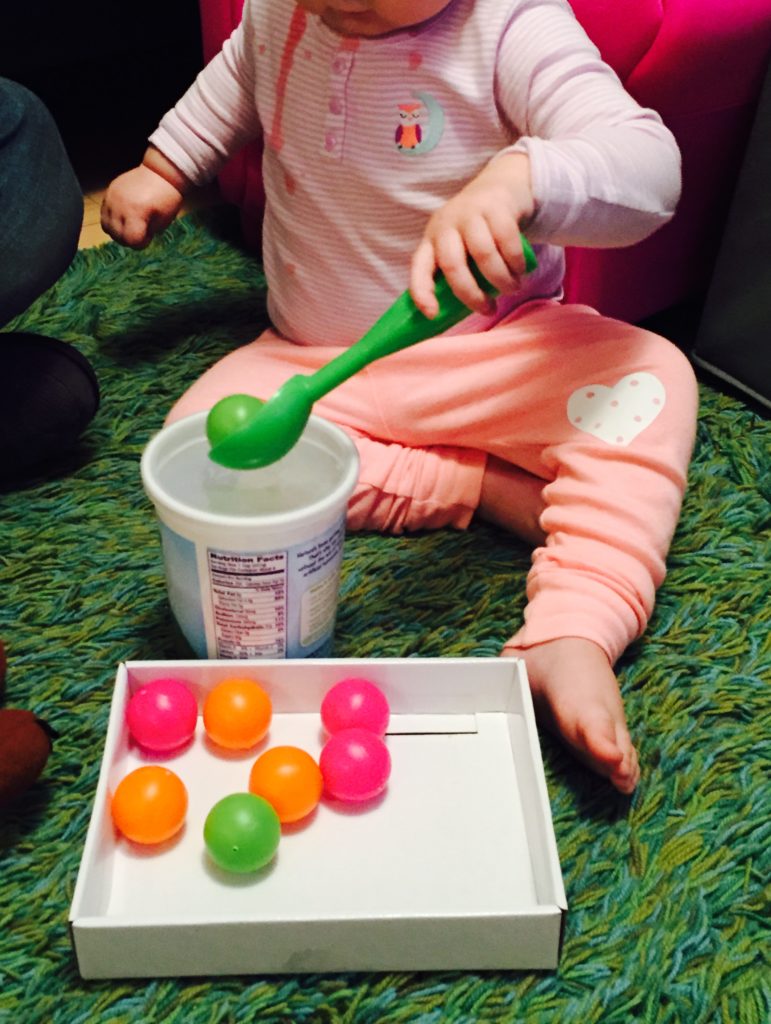
1. Make a sorter with ping pong balls and a yogurt container.
You can really create sorters from anything, but these ping pong balls are so colorful and bright, that I decided to use them for sorting. Cut out an opening in a container slightly larger than the size of a ping pong ball(it’s hard to see an opening in this picture since the lid is clear). A toddler’s task is to get a ball in the container using an ice cream scoop. Younger toddlers can use their hands instead of a scoop. Great for the development of hand-eye coordination.
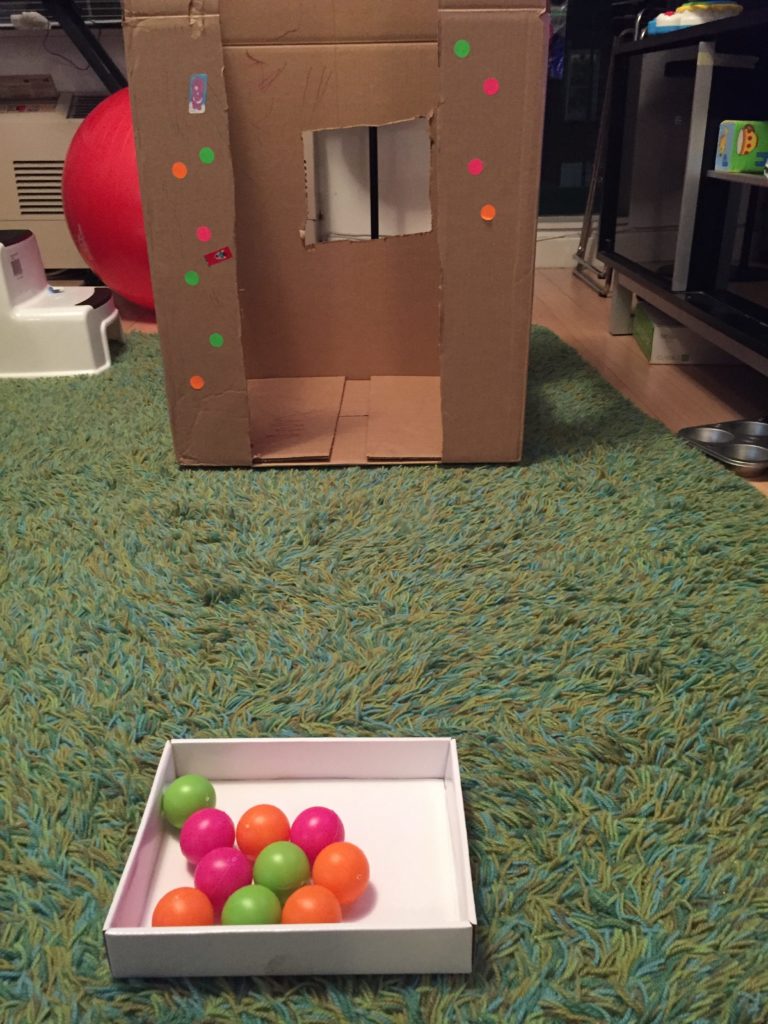
2. Throw ping pong balls into a box.
This is another activity that we do with these ping pong balls. The goal is to get balls inside a box. We have been using our cardboard house for this purpose but any box would work. This was a success because our toddler loves to throw stuff. Great for hand-eye coordination, gross motor skills, and it’s fun for the whole family!
3. Search for animals in a tray of tissue paper.
Tear up tissue paper into pieces and hide animals underneath. When your toddler finds each one, you get to repeat animal names and sounds or do a tickle attack by each animal. This is a great sensory activity and it helps language development if you talk about items you find. We tried a few sets of animal figures and found that Schleich animals have the best quality, they look very similar to how real animals look.
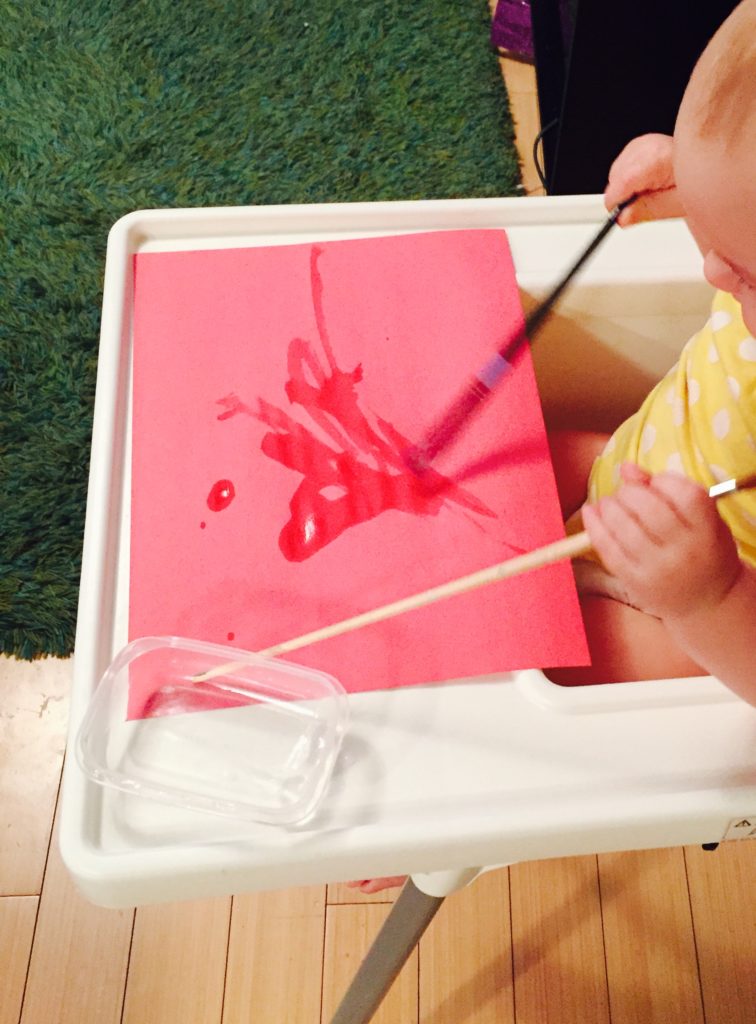
4. Paint with water on construction paper.
All you need is construction paper and water – the easiest setup and cleanup. Our toddler likes to use a brush, but some kids prefer to paint with fingers or sponges. Great for the development of creativity, sensory awareness, fine motor skills.
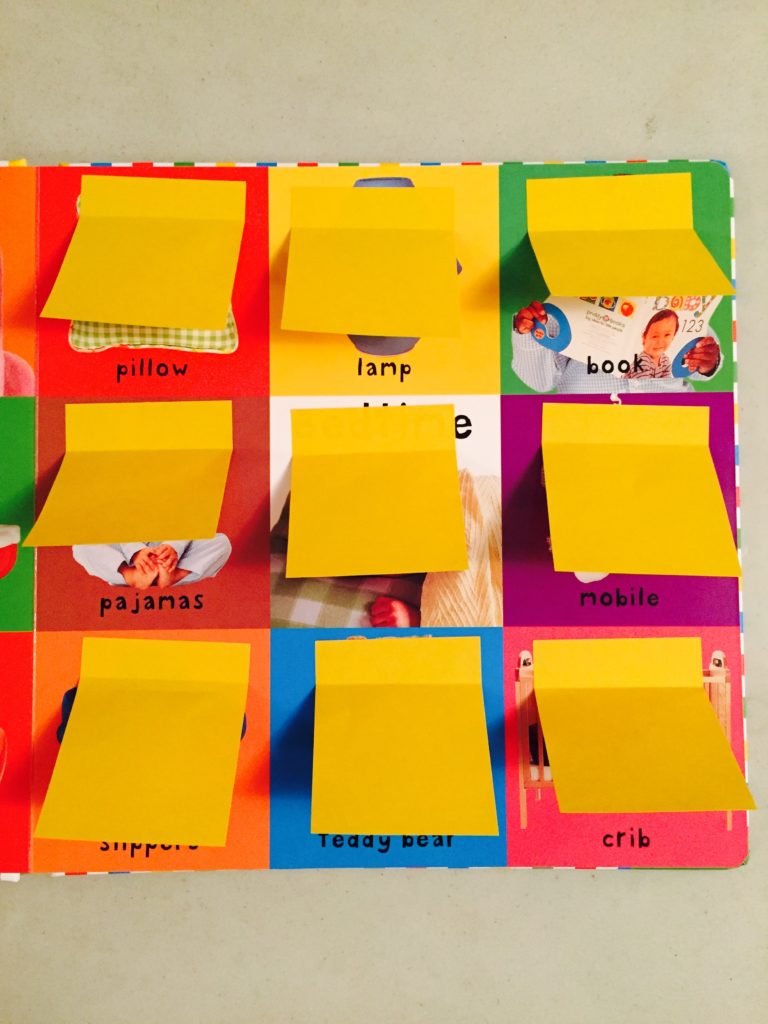
5. Sticky note peek-a-boo
A book can become suddenly more interesting when you add sticky notes to it. It works especially well with this book First 100 Words Board Book because every page is split into sections and has a variety of pictures and words to learn. Just add sticky notes to create flaps. A toddler can interact with a book now by either lifting flaps or taking them off. Scarlett gets excited when she takes the sticky note off to discover the picture underneath, and we get to learn new words.
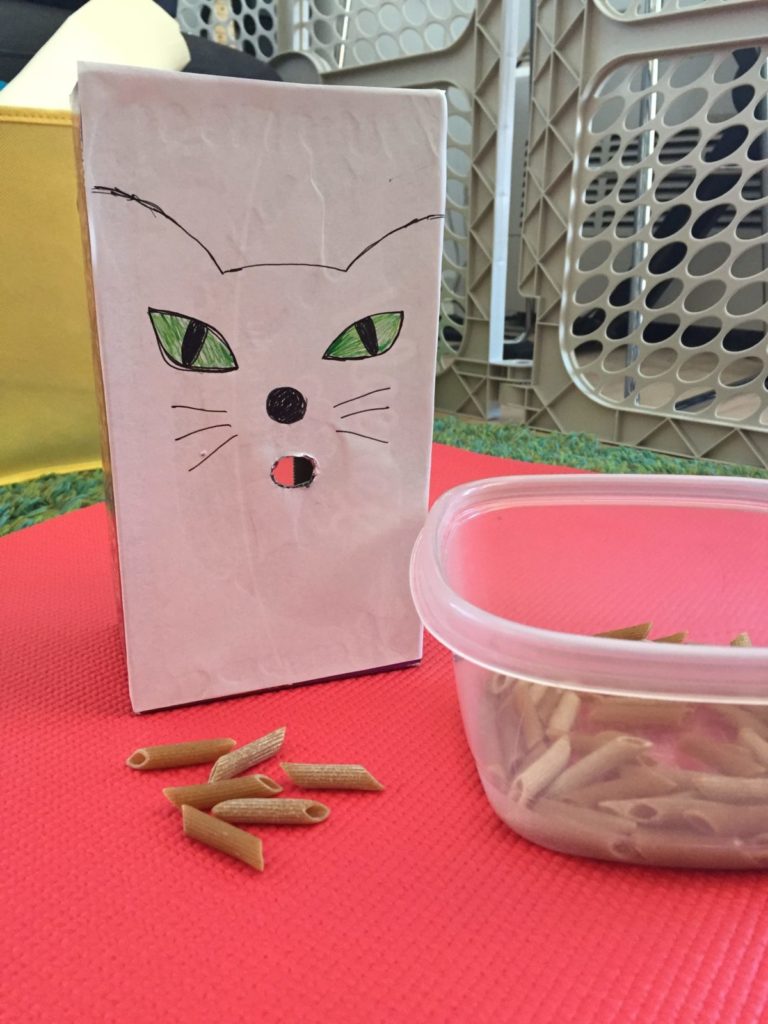
6. Make a cat feeder from a tissue box and pasta.
Tissue boxes are perfect for feeding activities because it’s easy to get things out of them through the tissue opening. Draw a face on it, and make an opening in the mouth area and you got a pet to feed. We feed pets with pasta. If your toddler is putting everything in the mouth, you can substitute raw pasta with blueberries or Cheerios – that way everyone gets to eat.
7. Play with colored rice.
There are so many ways to play with colored rice. You can read details in my article about 12 ways to play with colored rice.
8. Draw on a cream of wheat.
Little artists can express themselves by drawing on a layer of cream of wheat on a tray. Besides drawing with fingers, you can also show your toddler how to draw with a q-tip or a craft stick. Cookie cutters can also be used for leaving shape marks.
9. Hide a toy under a blanket.
This activity is so easy, it can be played any time, and is always a hit. I hide a toy underneath a tablecloth/sheet and my toddler is trying to find it. When she finds it, I hide another one, so this activity can last as long as you want it to. Scarlett loves it so much, that she would bring me a tablecloth all the time to show that she wants to play.
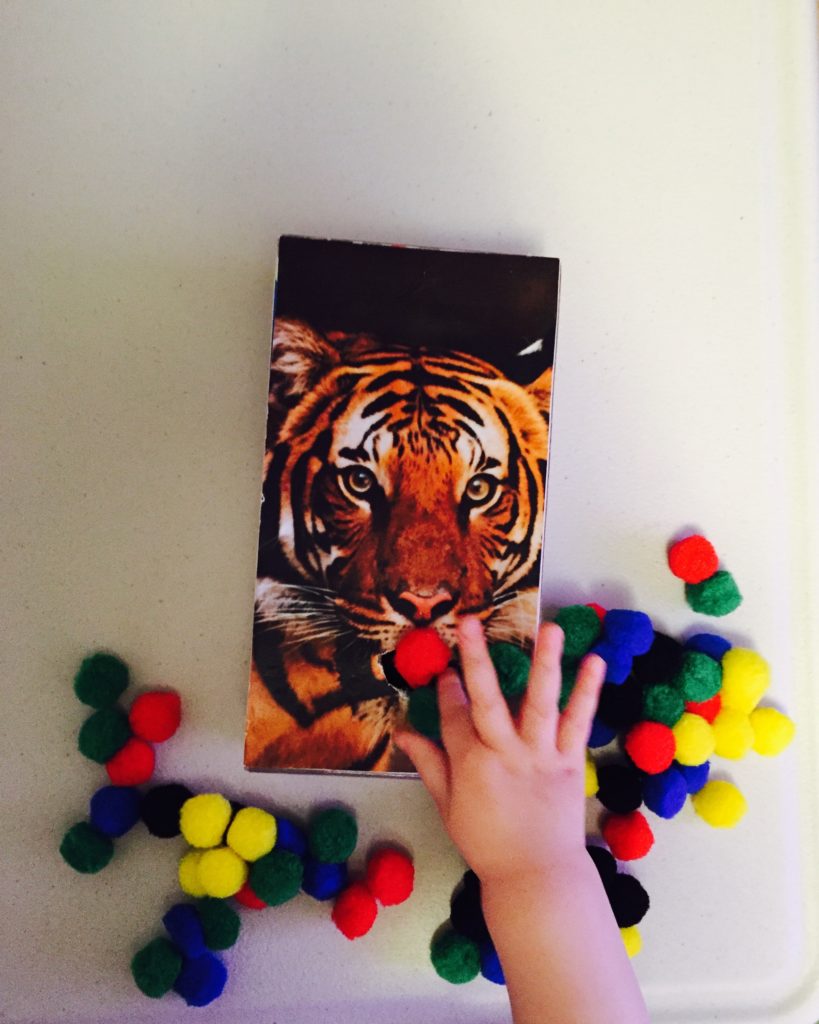
10. Feed an animal with pom poms.
It’s good to use different sensory materials for sorting purposes so kids can learn to handle different types of objects. PomPoms are great for sorting because besides practicing pincer grip, a child also has to push them through the opening in a sorter. We made a sorter with a tissue box, but any container can be used as long as you cut an opening about the size of the pom poms.
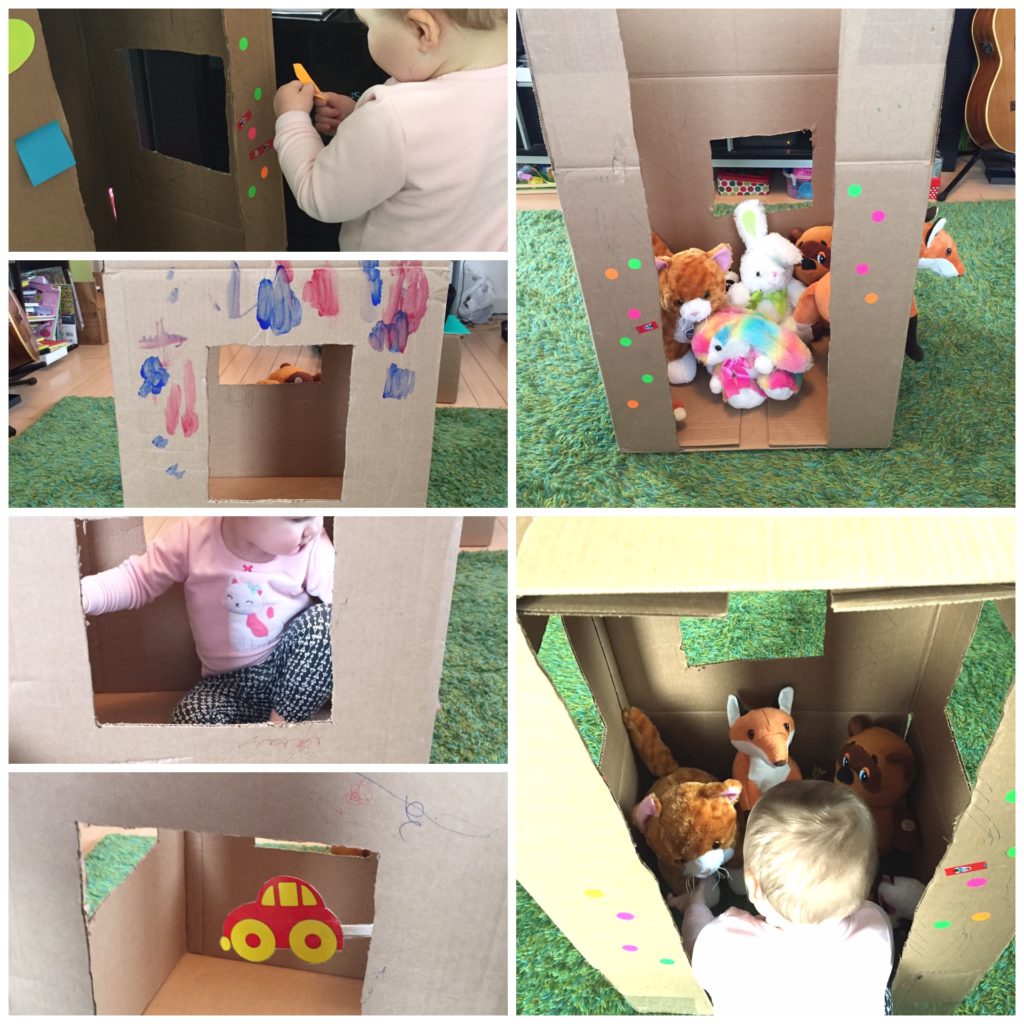
11. Make a cardboard house.
Boxes are very valuable when you have a toddler around. Convert it into a house by cutting out windows and a door. You can read a detailed description about 6 ways how we play in a cardboard house here.
12. Play with poke-a-dot book
I just can’t recommend enough this book. I saw it at a friend’s house and Scarlett would not stop playing with it so I had to get one of our own. Each page of the book has raised buttons that pop when you press them. It’s such a fun way for kids to practice fine motor skills. We also count how many buttons she pops on every page. I just wish I found out earlier about this book because it’s one of a few things that keeps her attention and gives me a little break.
13. Ice pops sensory play.
This is a great activity for educating young senses. It can introduce toddlers to the concept of cold/frozen, and they can learn about colors, length, and shape. This can be a great vocabulary lesson if you talk about these qualities of ice pops. As children learn to connect words with objects, the world takes on a new meaning for them.
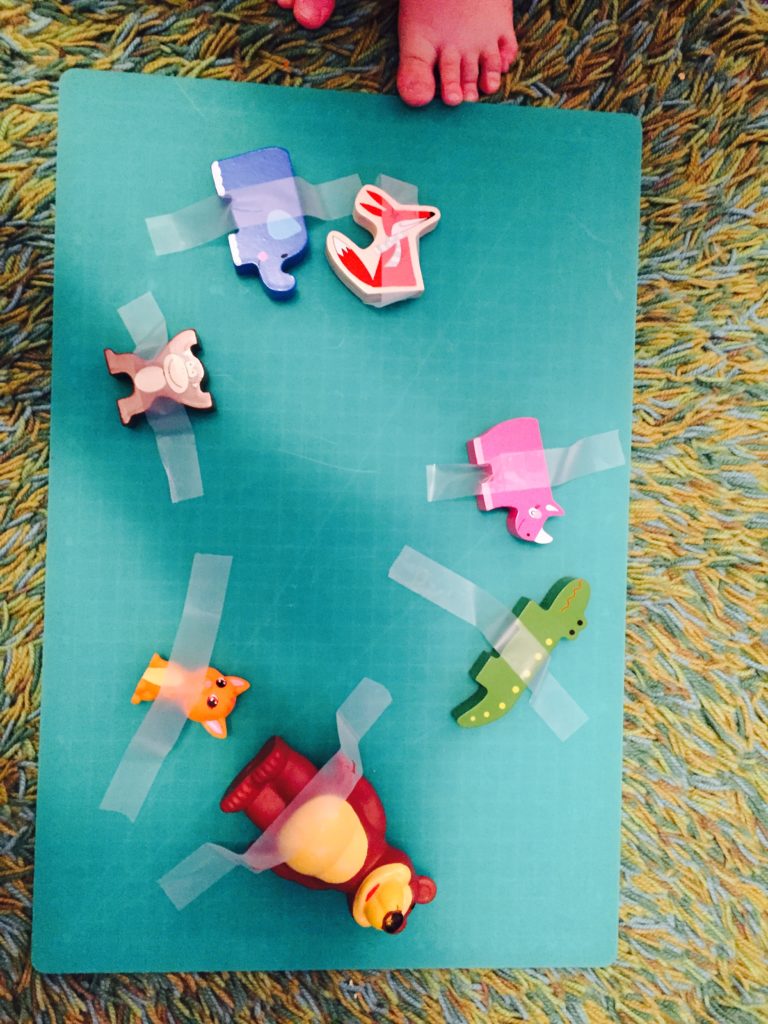
14. Scotch tape toys for a toddler to take off.
This activity is great for practicing pincer grip and fine motor skills. Tape a few toys to a table or a tray and have your toddler take them off.
15. Walk on sensory bags.
Old baby socks can be turned into sensory bags. Fill them with beans, rice, pasta, cream of wheat, flour, or any other grains. Your toddler can enjoy playing with them, touching them, hiding them in boxes, or walking on them.
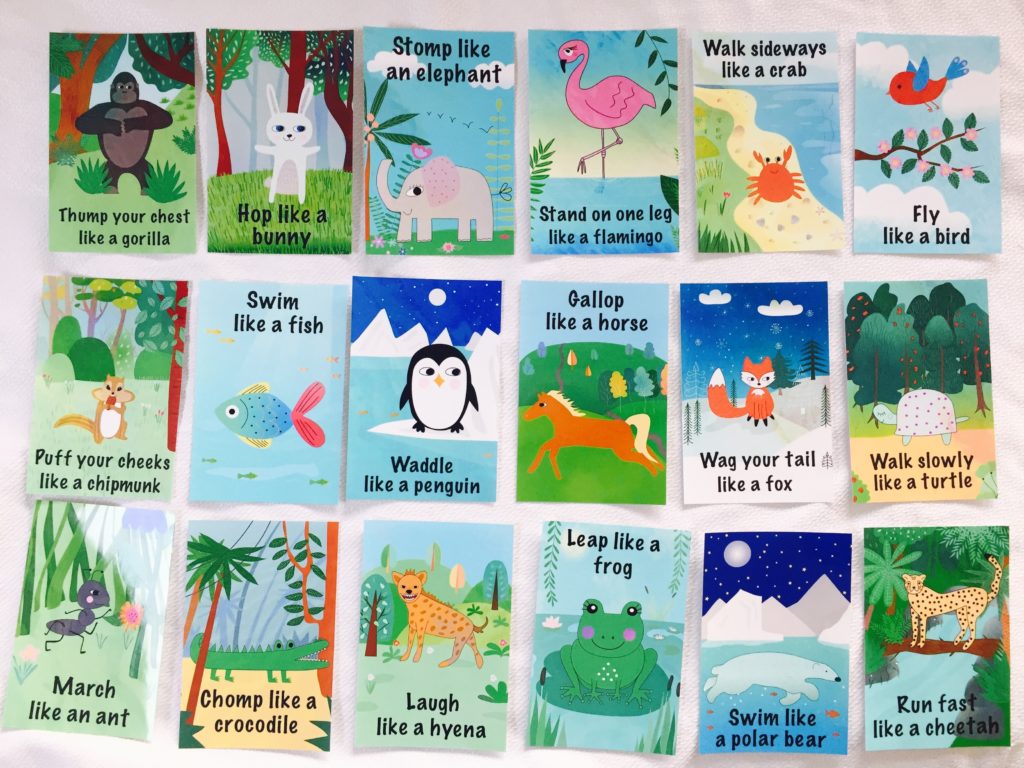 16. Animal action cards
16. Animal action cards
Animal action cards are a hit with Scarlett. She started to do some of these actions when she was about 15 months old. I selected the actions on the cards that she can do now and put the others away for later. I showed her how to do the actions the first time we played with these and now she does them on her own. It’s fun for the whole family, we clap when she does it right, and she gets to let her energy out in a fun way. The digital version of these cards is available here and a printed version is here.
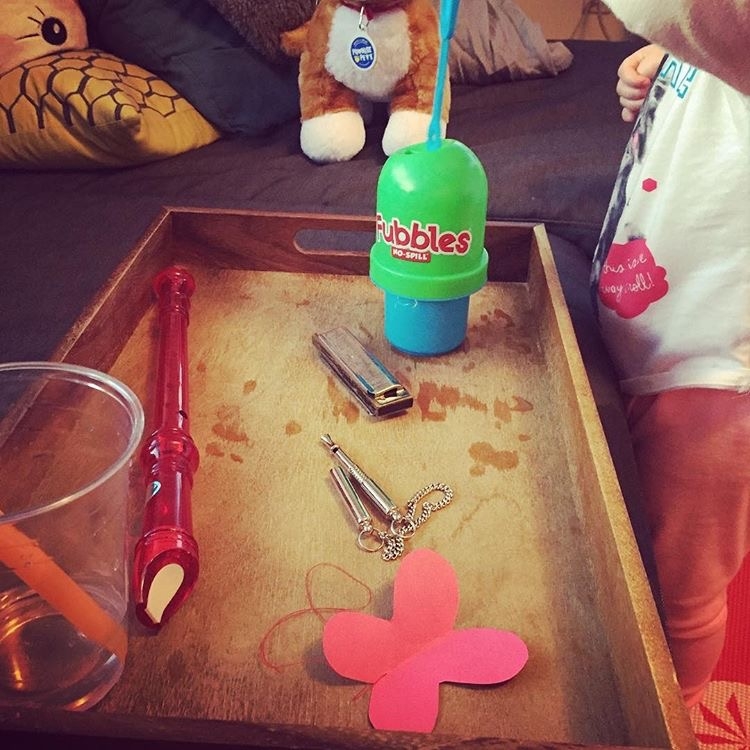
17. Blowing activities.
Blowing activities are very important for the development of oral motor skills as they teach the muscles to move in the right way. These skills are very helpful for speech development. Oral motor skill exercises help develop strong and mobile articulators (lips, cheeks, jaw, and tongue). The ability to blow is essential for sound production. Here are some activities that help develop those skills:
- Blowing bubbles. We found these really cool no-spill bubbles Fubbles that are appropriate for this age.
- Blowing a whistle, there are some cute Animal Wooden Whistles
- Blowing cotton balls or pieces of tissue paper from your palm
- Blow in a straw in a cup of water to make bubbles
- Blow Lip Whistles
- Blow on a paper butterfly on a string to make it fly.
- Play a Wooden Recorder
Be careful to only do these activities for a little bit at a time since blowing for extensive period can make a person dizzy.
Benefits: learning to coordinate lips, cheeks and jaw, increased speech sound variety and improved speech clarity.
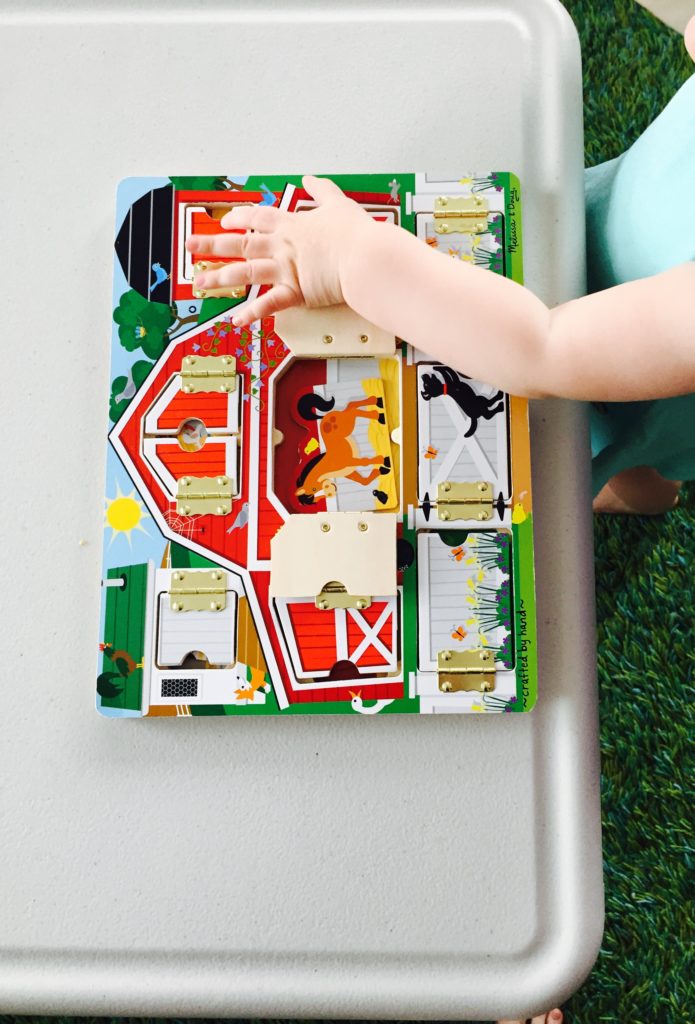
18. Play with a hide-and-seek board.
This board has been a hit for us. Scarlett loves to open little doors and discover an animal there. We learn animal names and animal sounds like that, and it’s also a great memory game. I was surprised to find out that she remembers where each animal lives. Great for memory development, fine motor skills, and language development.
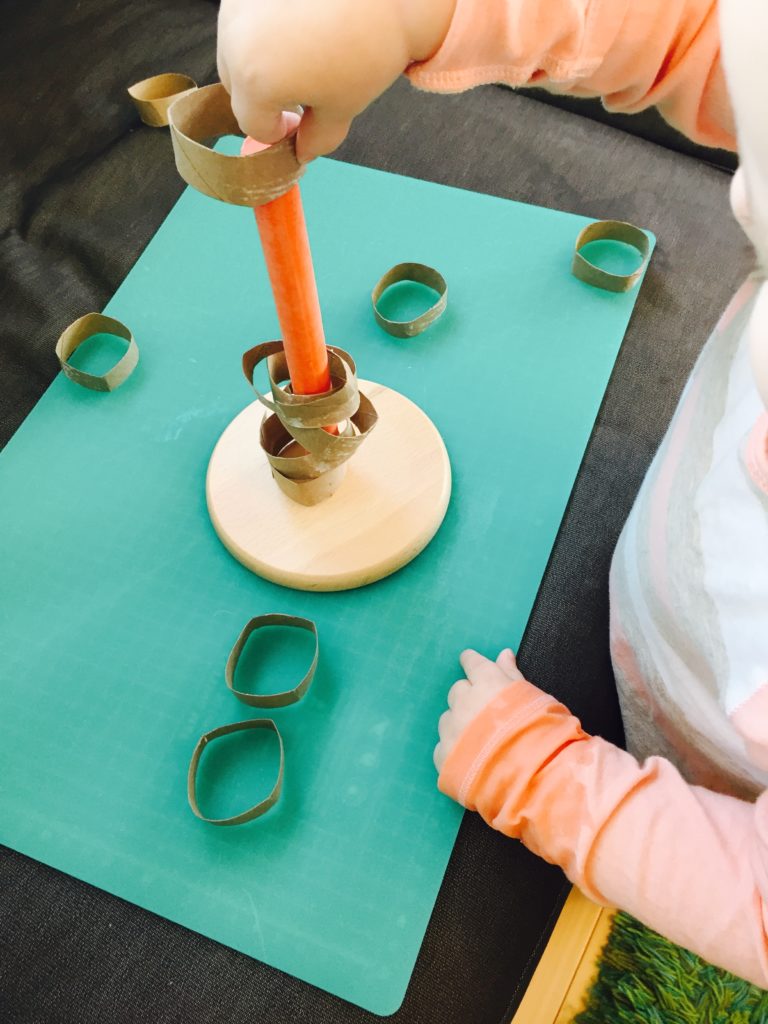
19. Put on paper towel circles onto a paper towel holder
Cut a paper towel roll or toilet paper roll into smaller circles, and show your toddler how to put it on a paper towel holder or a stacking tower holder. Plastic cookie cutters can be used for stacking as well.
20. Water play
Probably all kids like to play with water. I don’t add coloring to the water because Scarlett plays with cups in the water and sometimes would drink it, which is a great self-care skill. We also add small plates to put animals there to float, and we like to play with Stacking Cups and watch the water go through the openings on the bottom of cups.
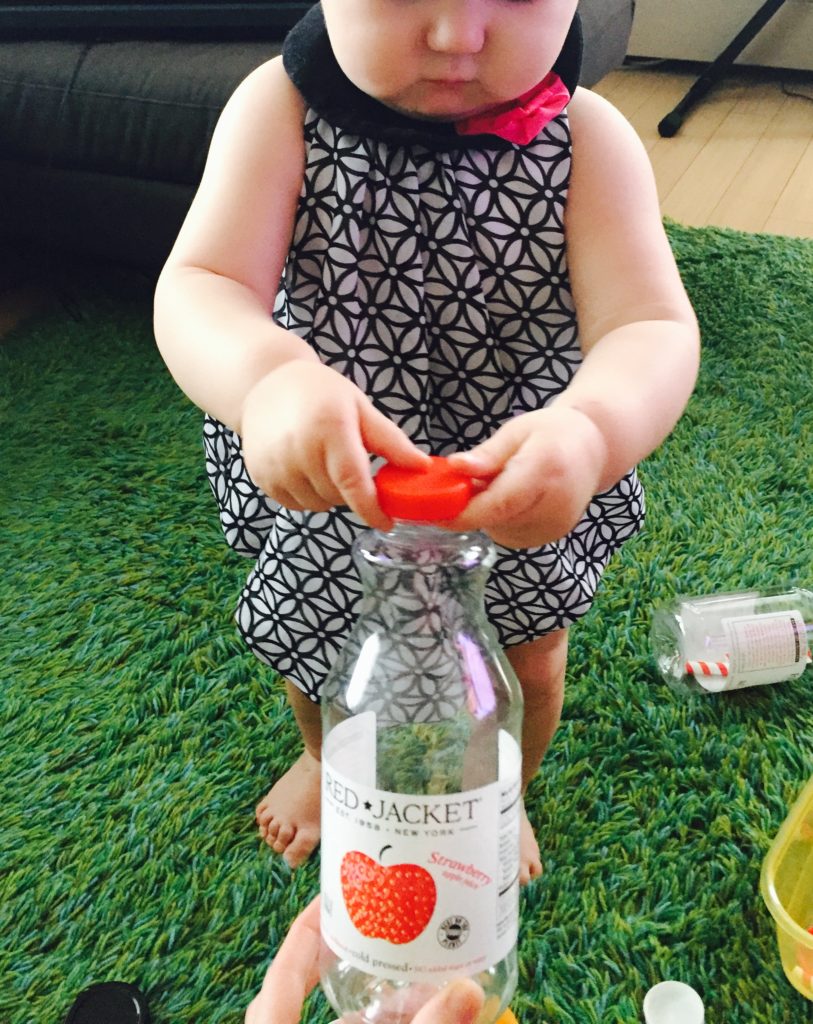
21. Match lids to bottles.
This is an easy-to-set-up activity that your toddler would probably like. All you need is a couple of empty plastic bottles and lids. It’s tough for little hands to put a lid on a bottle, they might need a lot of practice. It gets more challenging when there are lids of different sizes and they need to pick the right one.
Benefits: development of fine motor skills, grasping, and shape and size recognition.
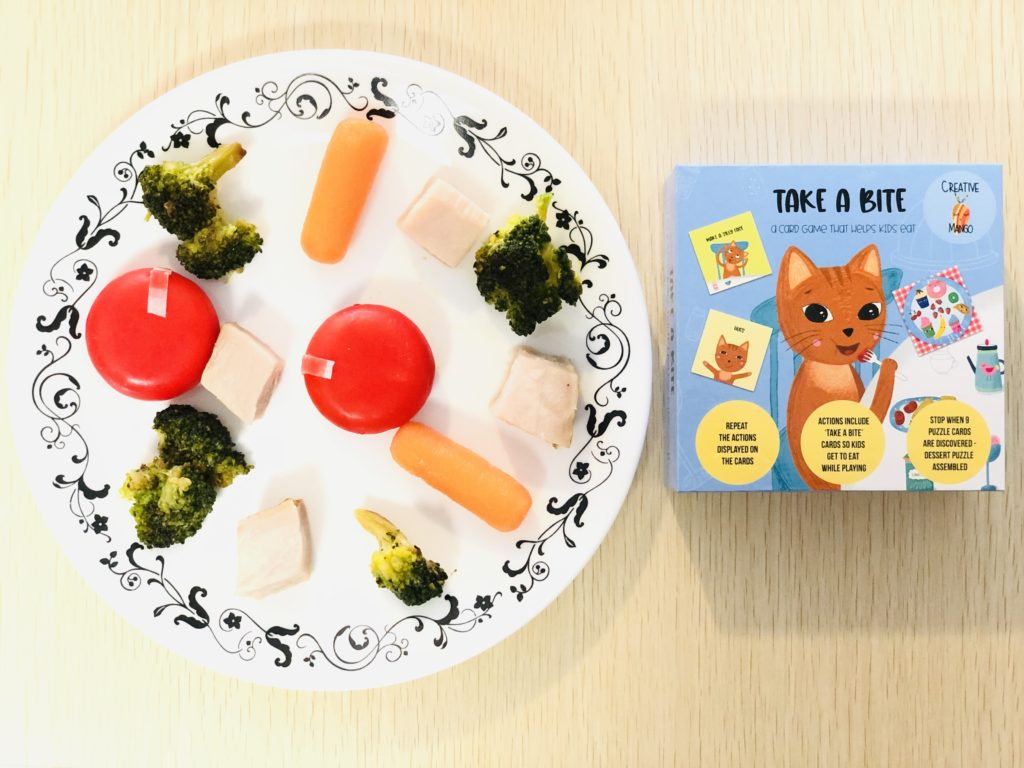
22. Play a game with food
My daughter is an extremely picky eater, so I try to include games with food in our routine as well – surprisingly they help her eat a lot more food than she normally does. We use this Take a bite game which is based on actions that kids need to repeat. Some actions are funny, like ‘make a silly face’ or ‘tickles’, some actions are cute, like ‘hugs’, and some actions say ‘take a bite’ – so my daughter eats bites of food in between other actions. This game has so much cuteness with plenty of hugs, tickles, and kisses with your child.
23. Car restaurant pretend play
I underestimated the benefits of pretend play. You can teach kids so much by pretending to do various things. For example, here we made a restaurant for our favorite toys (cars), we set up plates and cups and pretended that the cars were eating and drinking. I took a psychology class recently and learned that through pretend play you can work through different scenarios. For example, you can make sure that the cars wash hands before eating, and if one of the cars didn’t wash hands it might have gotten sick. For older kids it’s very interesting to play school with kids, you get to find out what’s happening in school. You can pretend that one classmate is not treating another classmate right, and how to handle things in this case. Pretend play is a safe place for kids to experience emotions since things are happening not to the children themselves but to the toys.
24. Build a tower from anything
Our toddler loves building towers and destroying them. We’ve been using various boxes, paper towels, toilet paper, tissue boxes, and blocks. Anything stackable will work. It’s a great gross motor activity for the little ones.

25. Walk on Touch and Feel books
Sensory books are great for exploring with babies and toddlers, but they are also great for touching them with their hands and feet. We made this sensory activity by laying a few Touch and Feel books on the floor, and walking on them. I did it too, it feels great on your feet! 🙂 Our favorite sensory books are from “Never Touch a” series: Never Touch a Dinosaur!, Never Touch a Polar Bear!, Never Touch a Porcupine!. Alternatevely, this activity can be done with various textures you have in your house, like aluminum foil, bubble wrap, soft blanket, etc.
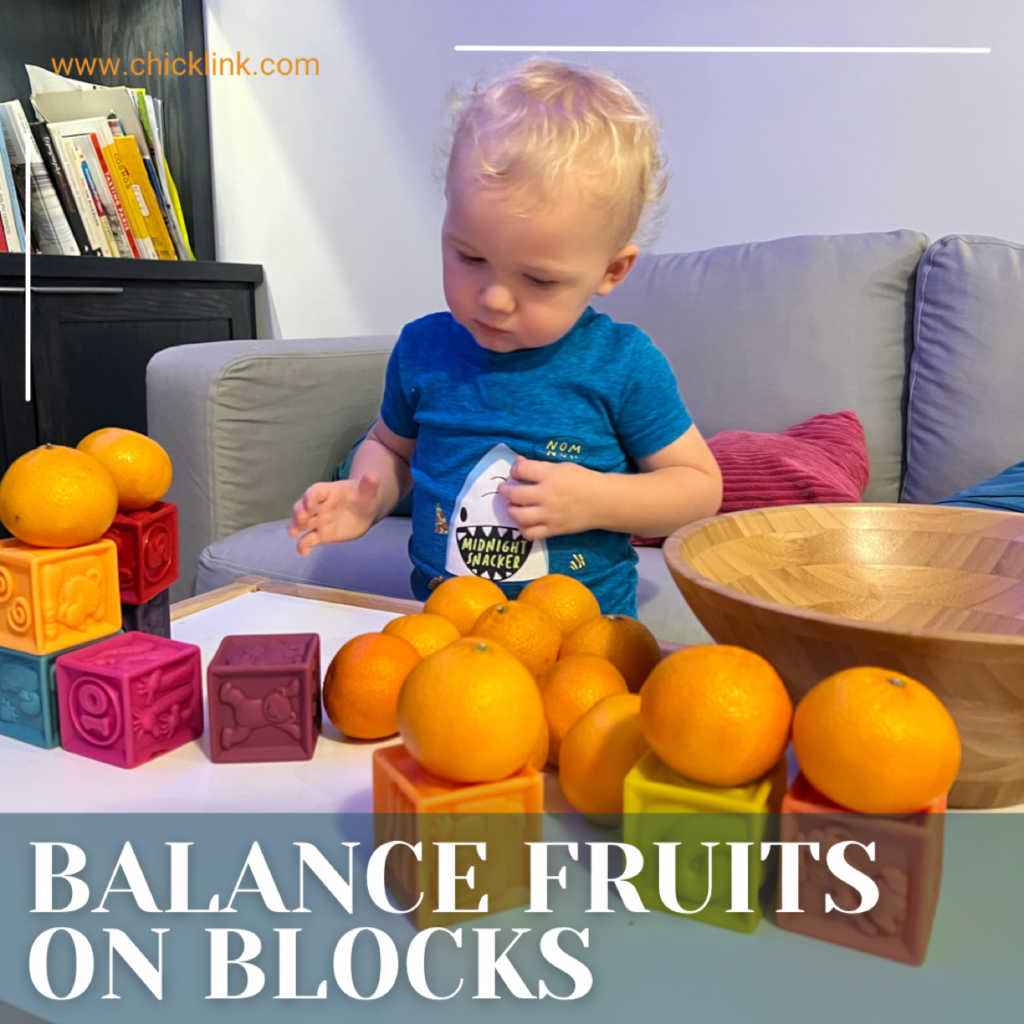
26. Balance fruits on blocks
I couldn’t believe how much time my toddler spent organizing oranges on top of building blocks. He built towers with blocks and balanced oranges on top of the towers, and also on top of each individual block. He was literally busy for 20 minutes! (Things rarely keep his interest for a while). We used squeezable rubber blocks.
____________________________________________
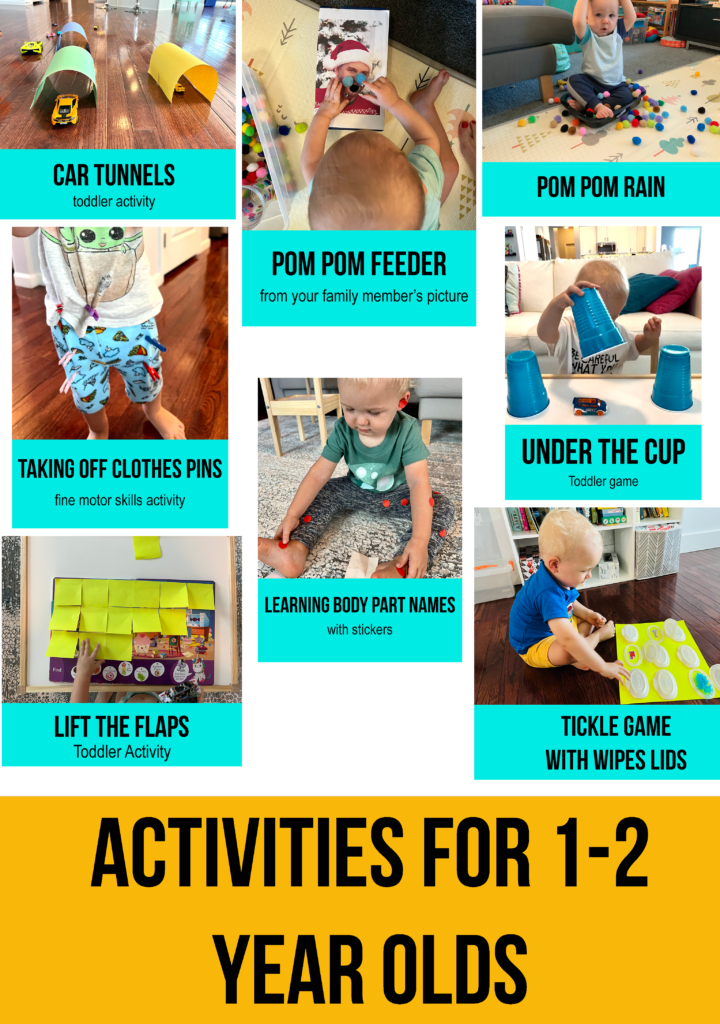
Feel free to check out another post with activities for 12-24 month olds which I wrote after I had my second child: Activities for 12-24 month olds.
Sign up for my newsletter to be notified when new articles about toddler activities come out.
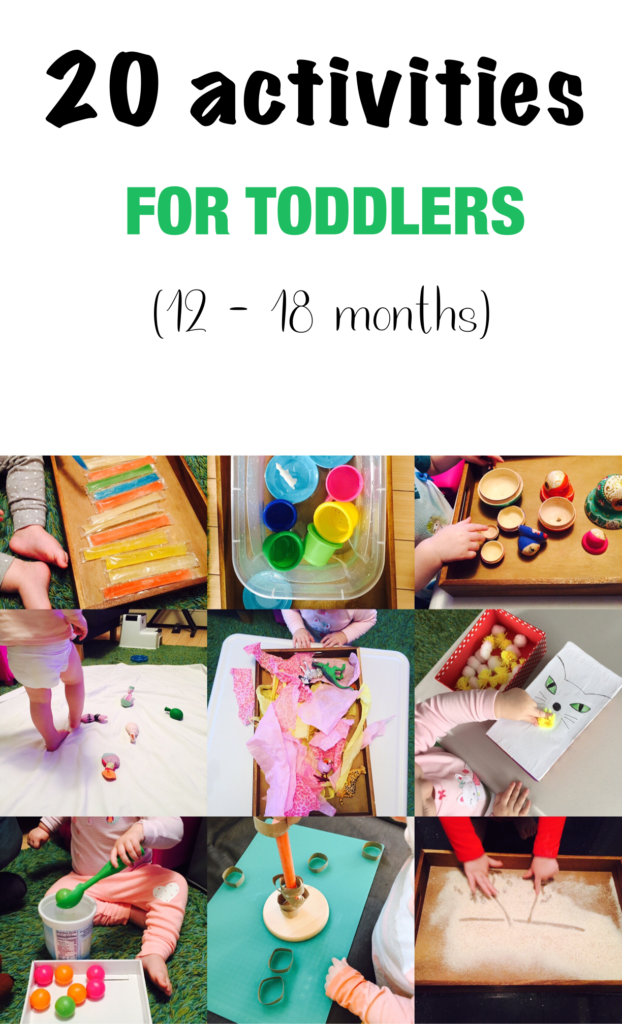
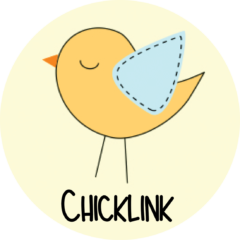


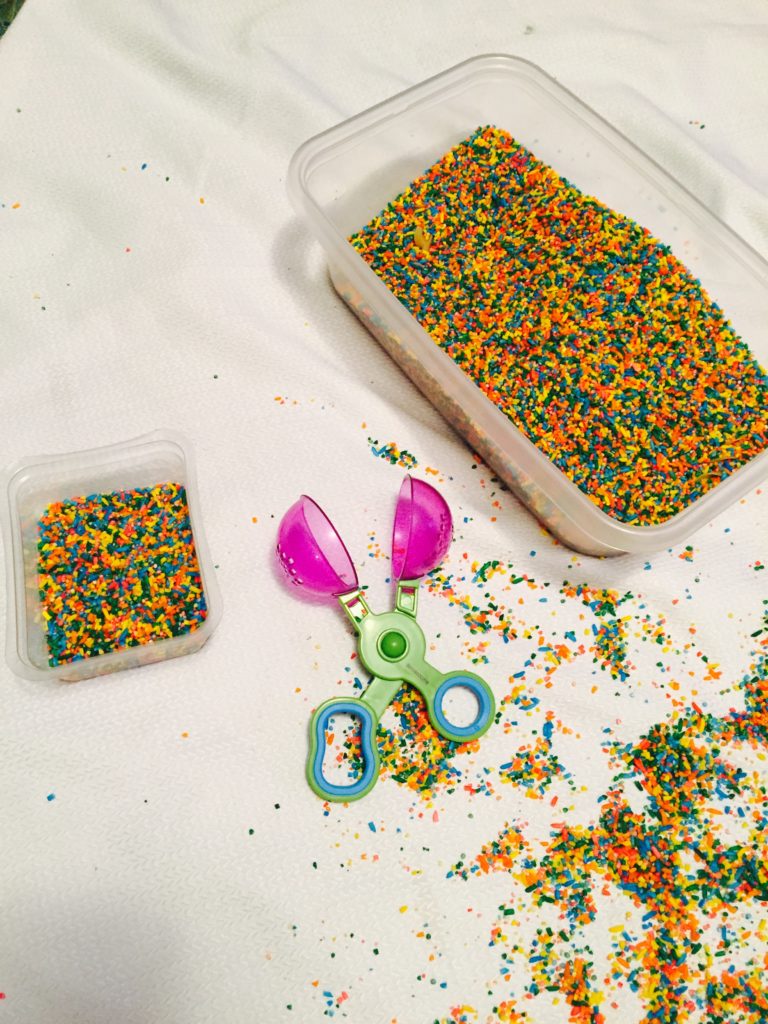
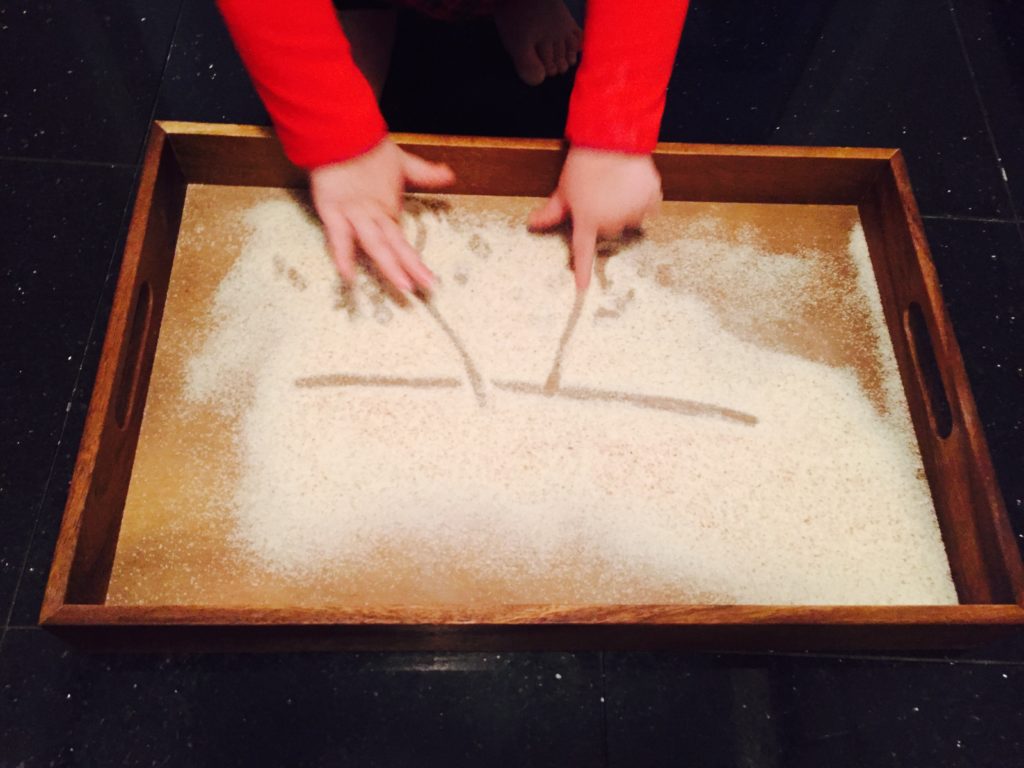
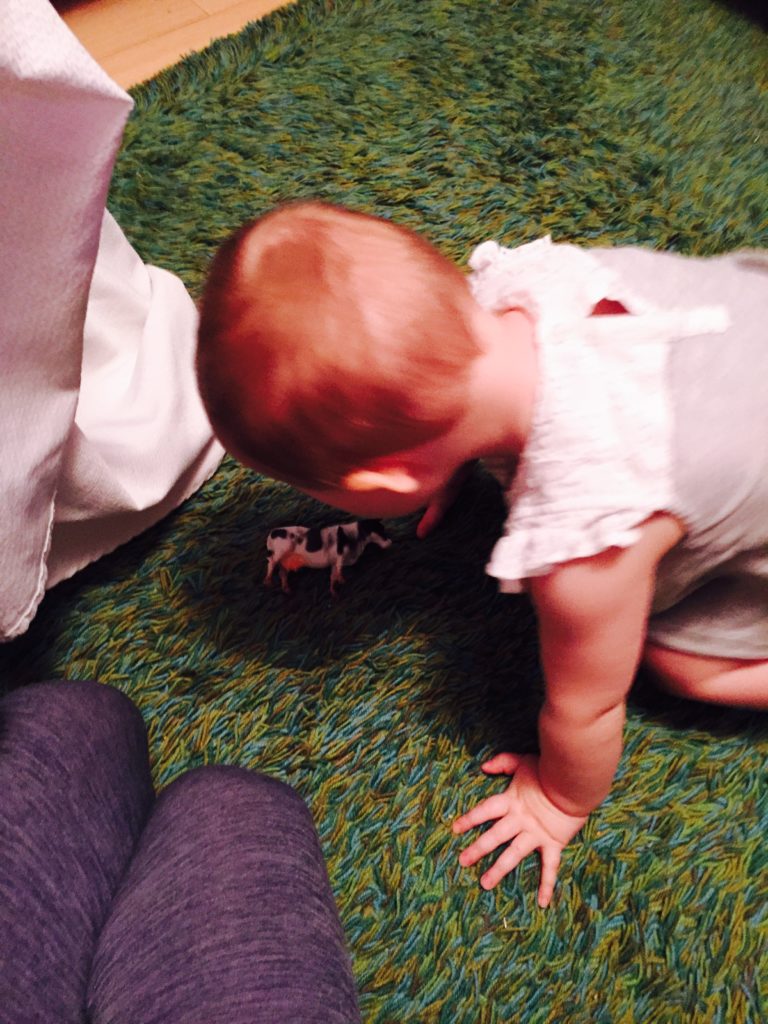
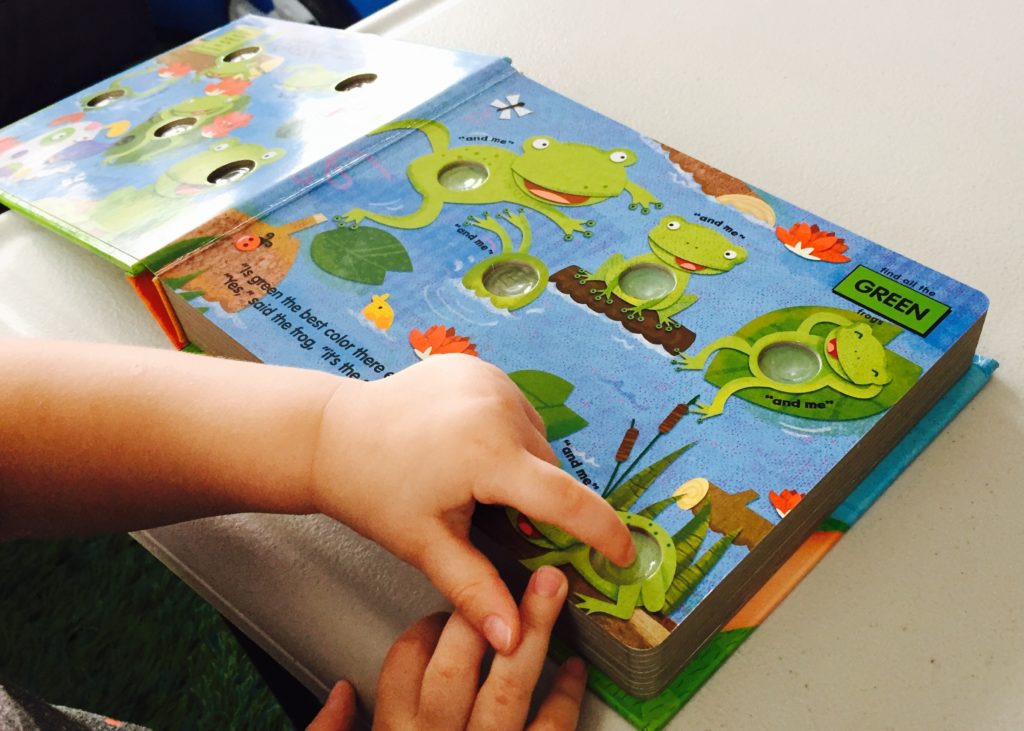
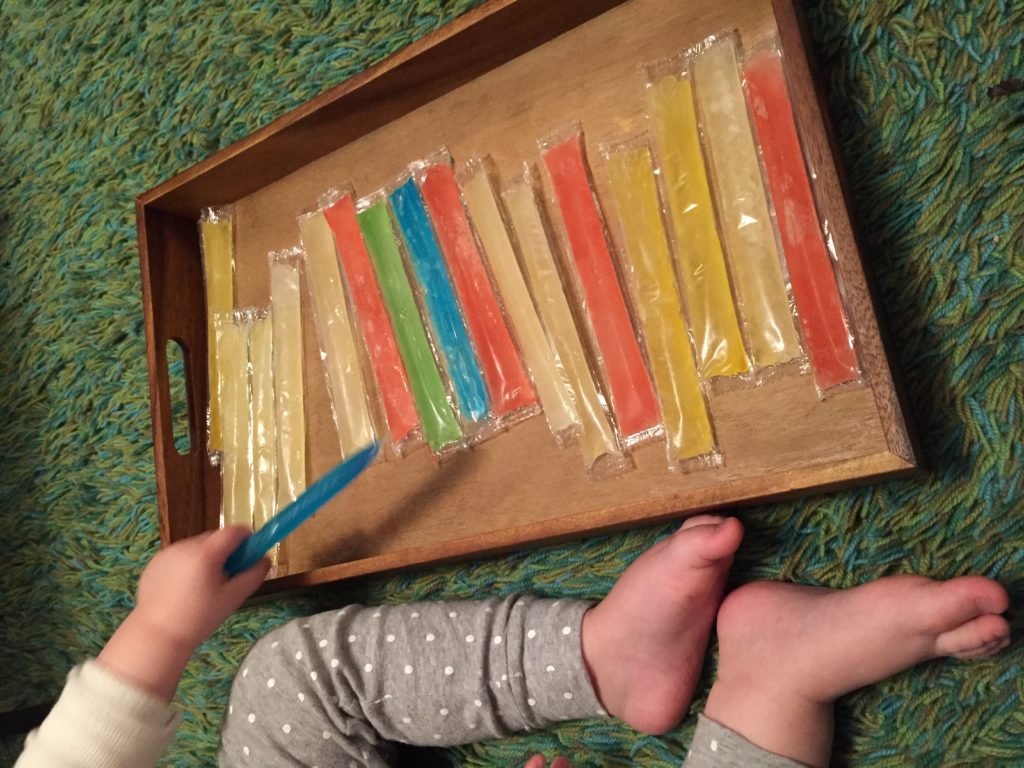
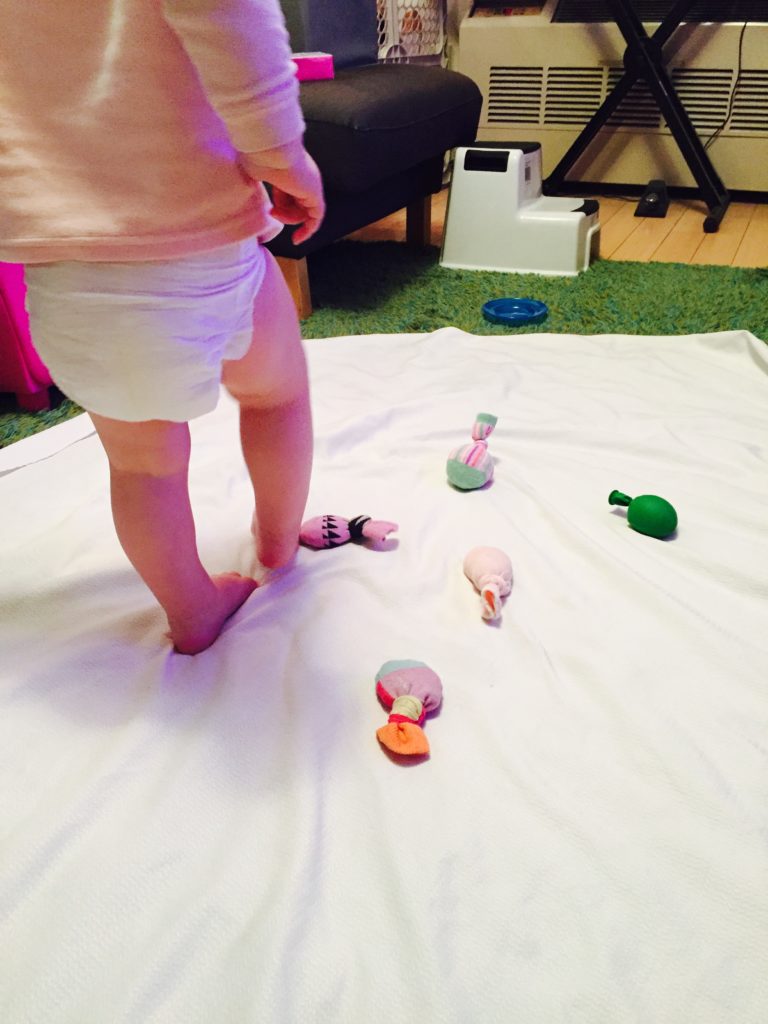
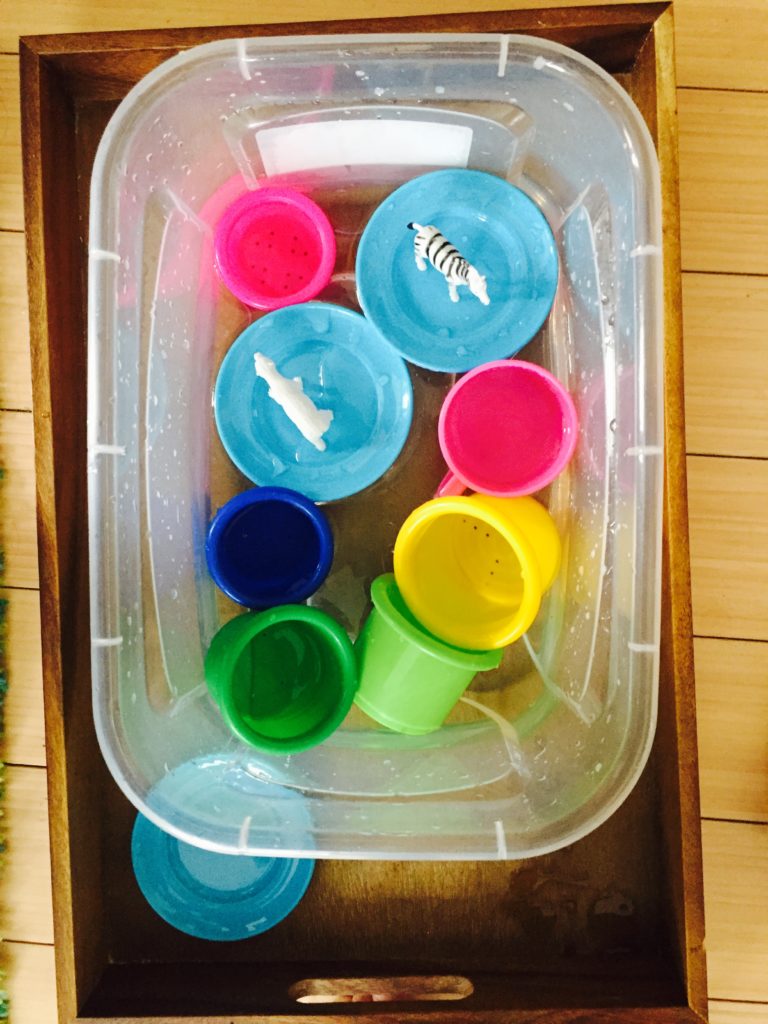
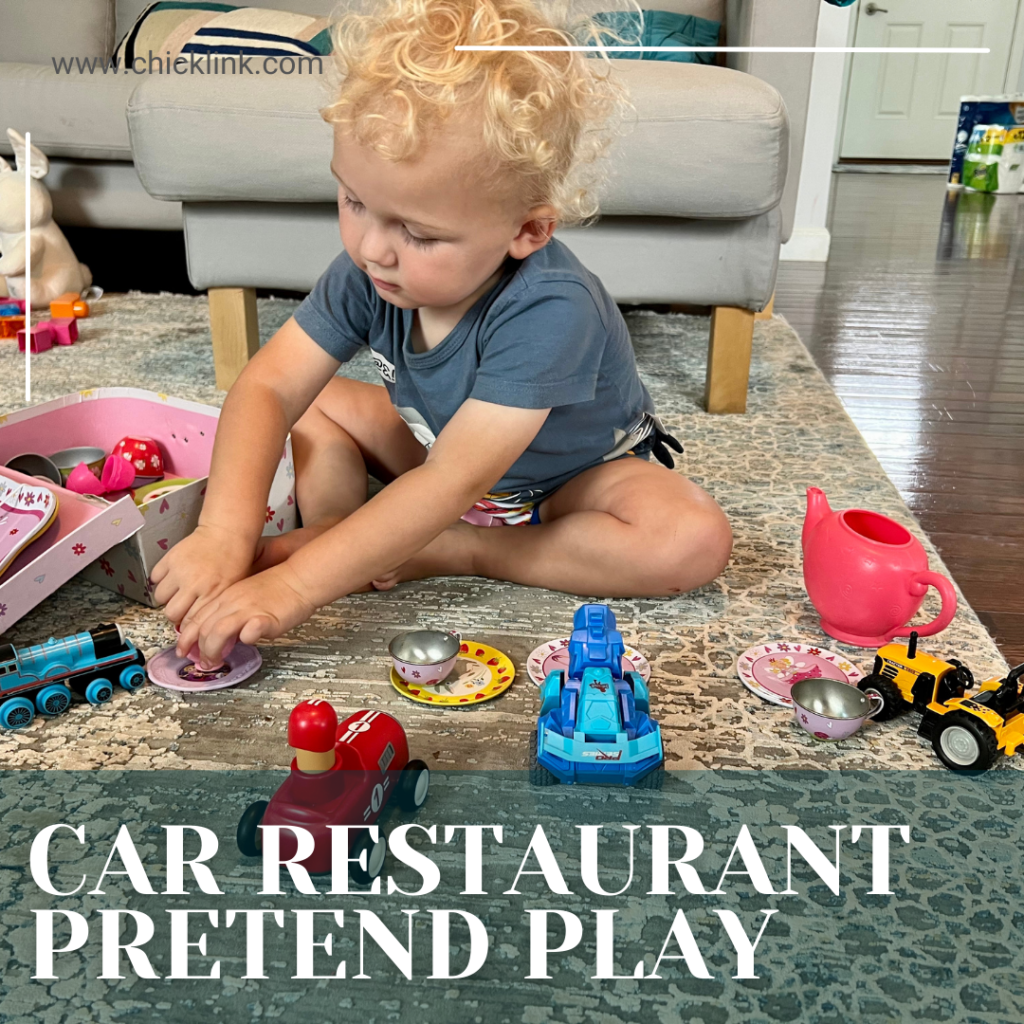
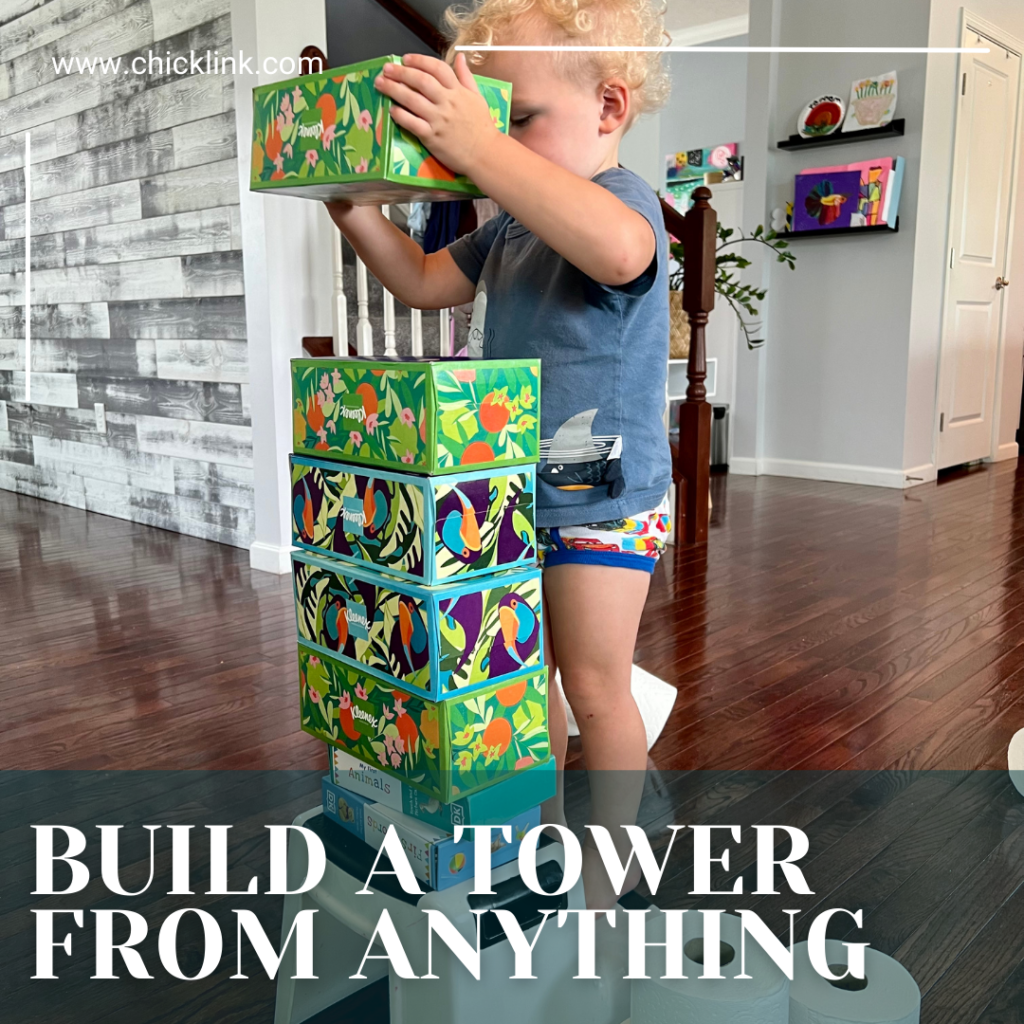
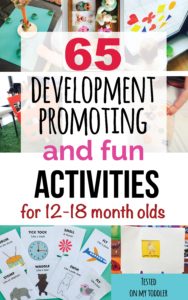
This article was so helpful, I feel like I have done every activity with my daughter and shes only 18 months so im glad I came upon this! I love the fact that everything is cheap, not very messy, and most of all that they all have some sort of reasoning behind them. Thank you and keep up the good work! 🙂
Thank you for kind words! I’m glad you found some activities that your daughter liked 🙂
Inspiring!
Thank you!
This is Great! I work from home, and my daughter has been addicted to my phone(shame) These activities look like they would be a hit for her.. she’s gotten so busy lately! it’s a good thing, but i was ill-prepared.
Thank you! I hope your daughter likes them!
I love these ideas but with most of them I’m thinking “That would go in the mouth immediately” Does your daughter not try to put everything in her mouth? Especially the colored rice worries me but looks so fun. Any ideas for mouthing everything?
Also, do you only do one of these activities/trays a day? Or do you continuously get out a tray when she’s bored with it?
I’m wanting to get better at giving only one activity instead of having tons of toys strewn out, but my son gets bored pretty quickly and wants to move on to the next thing.
Thanks!
Scarlett goes through periods when she doesn’t put things in her mouth and then she suddenly starts to. I’m usually next to her when we do these activities and if I see her trying to sneak something in her mouth, that activity is stopped right away. She hasn’t tried to put colored rice in her mouth, but she would occasionally try to eat raw pasta, so I substitute feeding the cat activity with Cheerios or blueberries.
Looks like you already read my post about Daily Toy Rotation – I rotate activities between 7 days of the week, so she would not get tired of them. I’ll respond the rest there 🙂
These look fun and very little mess. I have an 18 month old granddaughter and i cant wait to do some different things with her. She seems bored with all the toys she has now. I tried to click th link for the 7 day toy rotation but it says there is no site
I really hope your granddaughter likes some of them! And thank you for telling me about the not working link, I just fixed it.
I love your ideas and look forward to trying them! One comment I do have to make as a licensed speech language pathologist is that research has shown that non-speech oral motor activities are actually not beneficial for developing good speech articulation. To benefit actual speech sound production, you need to practice speaking tasks. A great way to work on speech sounds with children in this age range is making animal sounds and other environmental and silly sounds such as trucks and trains, saying “uh-oh” “beep beep” and “pop” and other simple sounds and words. Thanks again for your fun post.
That makes sense! Thank you for your input, April!
Nice job i regularly view your blog and find it quite interesting.. keep up the good work and all the best.
Thank you!
As a retired special ed teacher, now grandma helping with a soon to be 16 month old- your blog is spot on. The layout with the large photos and short descriptions kept my interest all the way to this comment field. I also liked the way you responded to the Speech Pathologist- I worked with several in my last few years and I think the advice is good- but also the blowing activities are good just this age because they can indicate receptive language- “blow on this” and then when they do they are doing something observable. Great work and I will be copying some of the ideas this weekend. One addition: I went to Home Depot and bought various size “paint buckets” with the plastic lids and was able to create some similar “put in” activities with pom poms etc. by cutting a hole in the lid. When the activity was over- the buckets were handy for clean up.
I’m really glad you likes the ideas! Thank you for kind words, it’s especially nice to hear from a special ed teacher! It’s a good idea to use “paint buckets”, Scarlett is 2.5 years old now but we still do the activity of putting things in a hole once in a while, we are just using spoons to put objects in an opening now.
Fentastic
Thank you for sharing! These are such great ideas!
I’m so glad you like them!
Great to read
I enjoy playingveith my grandaughter and your activities are fsntasic.shes 14mnths old
Wonderful ideas! Have got loads of inspiration for what I can do with my 16 month old, playing with the same old toys isn’t interesting for either of us! 🙂
I’m so glad you found them useful!
Love your article. Lots of things to do with my one year old granddaughter. I am so excited. Thank you!!
Thank you for your comment! I’m so glad you liked the activities!
Many wonderful ideas, thank you. There are so many other great things about dramatic play however; language development, social and emotional intelligence, collaboration, emotional regulation, literacy and math skills… the list can go on! It’s the corner stone of early learning that shapes a child’s holistic development, and so much more. I hope you continue to explore into the self guided imaginative activities, thanks again!
Thank you for your comment! I didn’t think about all these benefits of the pretend play, I will add them to the post – thank you!